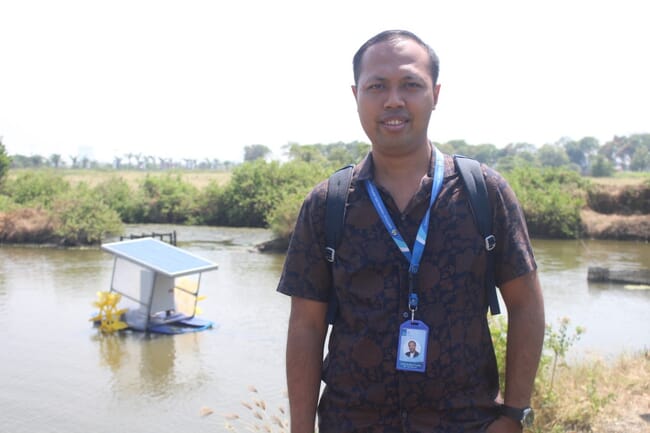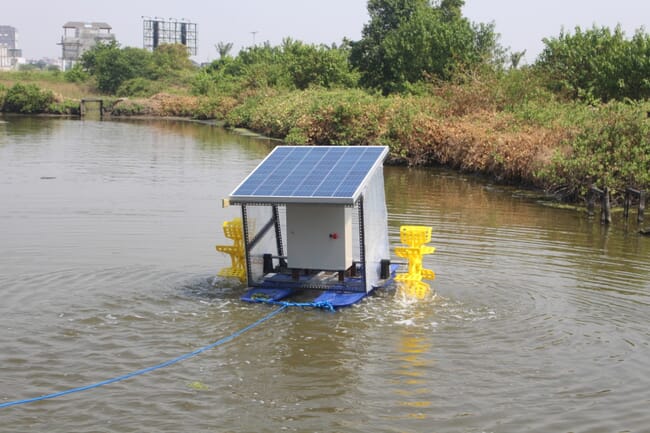
Putu Eka Widya Pratama SSi MSc RWTH in front of one of the white shrimp farmers’ ponds in Gunung Anyar Tambak Village, Surabaya
The traditional aerators used in shrimp farming require a substantial power source – without it, shrimp production isn’t as effective or efficient. To help address this issue, the Community Empowerment Real Work Lecture (KKN PM) team from the Institut Teknologi Sepuluh Nopember (ITS) created a photovoltaic-based aerator to strengthen the farmers’ production efficiency.
PM I KKN team leader Putu Eka Widya Pratama SSi MSc RWTH says that aerators are essential to provide oxygen supplies to farmed shrimp as they develop. The lecturer, who also goes by Eka, explains that his team chose Gunung Anyar Tambak Village, Surabaya, to implement the innovation because it is developing its own shrimp farming industry and is expected to become a digital village by developing renewable energy.
The photovoltaic-based aerator is a sunlight-powered tool that produces air bubbles that oxygenate the shrimp pond. This tool can increase the amount and quality of oxygen the shrimp needs in the pond. “That way, the shrimp will grow healthier and faster,” Eka explained.
In addition to using environmentally friendly energy, this tool will use a system that works automatically. Eka explained that when the solar panel is exposed to sunlight, it will release electricity which the controller uses to stabilise the energy output voltage from the solar panel. The controller puts the solar panel energy into the battery when the machine is not running – charging the battery.

A photovoltaic-based aerator, created by the ITS KKN PM Team, is working to provide oxygen in one of the white shrimp farmers’ ponds, Gunung Anyar Tambak Village, Surabaya
When the engine is running, the power from the motor is drawn from the battery and passes through the controller. When the charging voltage in the battery has reached a whole state, the controller will stop the electric current from entering the battery to prevent overcharging, improving the battery life. “That way, this aerator battery will last for 10-15 years,” said Eka.
The components used in this aerator consist of a 200 Wp 24VDC solar panel, an aerator frame as a place for installing solar panels, an eight-leaf windmill for paddling water and restoring oxygen levels, DC motor PG45 RPM 500 Torque 25 kilograms. It also includes a driving wheel, a buoy as a component lifter, as well as a box panel as a protective tool that uses the electricity network.
To activate the aerator, farmers only need to use the power button on the box panel, which functions to activate and deactivate the system. The motor will rotate the wheel automatically to produce air bubbles when activated. This aerator itself will work according to certain hours and minutes. “This tool will stop operating for four hours, from 11.00 to 14.00,” he said.
In the future, Eka hopes to apply the Internet of Things (IoT) technology to the aerator. IoT applications will let farmers control and monitor the aerator from home using an integrated smartphone. For now, Eka hopes that the existing aerators can increase the effectiveness of farmers’ production in Gunung Anyar Tambak Village. “Hopefully, it can improve the quality and quantity of shrimp farmers,” he said.




